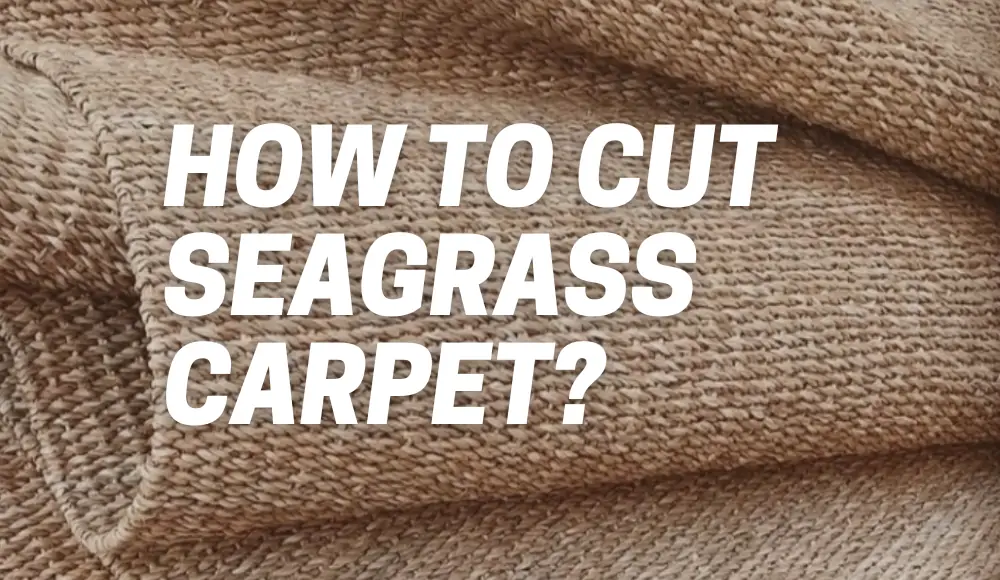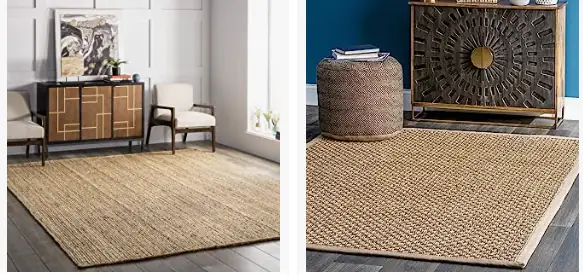Seagrass carpets have gained immense popularity in recent years, thanks to their natural appeal and eco-friendly qualities. These carpets, made from the fibers of seagrass plants found in coastal areas, offer a unique texture and visual charm to any space. However, when it comes to fitting them into specific areas, you might find yourself asking: Can you cut seagrass carpet? Will cutting it ruin its integrity?
In this article, we will explore the answers to these questions and provide you with valuable insights on how to cut and maintain your seagrass carpet effectively.
The Benefits of Seagrass Carpet
One of the main benefits of seagrass carpet is its durability. The fibers are naturally water-resistant, making it perfect for high-traffic areas or homes with pets and kids.
It’s also easy to clean – simply vacuum or spot clean with a mild detergent if needed.
Another benefit is that it’s a renewable resource – unlike synthetic carpets which are made from petroleum-based products.
Seagrass carpets are grown and harvested without the use of harmful pesticides or fertilizers, making them an environmentally friendly choice.
Can You Cut Seagrass Rug?
One of the most common concerns when it comes to seagrass carpet is whether it can be cut to fit a specific space.
The answer is, yes, you can cut seagrass rugs to the desired size.
Seagrass carpets are woven tightly, allowing them to withstand cutting without significant damage or fraying. However, it’s essential to approach the cutting process carefully to ensure the best results.
Can You Cut a Rug Without Ruining It?
Cutting a rug without ruining its overall look and integrity can be a daunting task.
However, seagrass carpets offer more flexibility in this regard compared to other types of rugs.
Here are some essential steps to follow to ensure a clean and precise cut:
- Measure Twice: Before making any cuts, measure the area where the carpet needs to fit. Use a measuring tape to determine the dimensions accurately. Take note of any irregularities or corners that might require additional adjustments.
- Mark the Cutting Line: Once you have measured the area, mark the cutting line on the back of the carpet using a fabric pencil or chalk. Double-check the measurements to ensure accuracy.
- Secure the Edges: To prevent fraying and unraveling, it’s crucial to secure the edges of the carpet before cutting. Apply a thin layer of clear adhesive or fray check along the cutting line. This will help strengthen the seagrass fibers and keep them intact.
- Use Sharp Tools: Employ sharp and sturdy tools to make the cut. A utility knife or carpet cutter with a new blade is recommended. Avoid using scissors, as they may cause the seagrass to fray or tear.
- Cut Slowly and Steadily: Begin cutting along the marked line, applying gentle pressure to ensure a clean cut. Take your time and maintain a steady hand to avoid any uneven or jagged edges.
- Check the Fit: After cutting, carefully place the carpet in the desired location. Check if any additional adjustments are needed before securing it permanently.
By following these steps, you can cut a seagrass rug without ruining its overall integrity and achieve a perfect fit for your space.
How to Cut Seagrass Carpet
Now that we know cutting seagrass carpet is possible, let’s delve into the step-by-step process to help you achieve the best results:
Step 1: Prepare the Tools
Before you start cutting, gather the necessary tools. You will need a measuring tape, fabric pencil or chalk, clear adhesive or fray check, and a sharp utility knife or carpet cutter.
Step 2: Measure the Area
Using a measuring tape, measure the area where the carpet needs to fit. Take precise measurements and make a note of any irregularities or corners that might require additional adjustments.
Step 3: Mark the Cutting Line
On the back of the seagrass carpet, mark the cutting line using a fabric pencil or chalk. Double-check the measurements and ensure the line is straight and accurate.
Step 4: Secure the Edges
To prevent fraying and unraveling, apply a thin layer of clear adhesive or fray check along the cutting line. This will help strengthen the seagrass fibers and keep them intact during the cutting process.
Step 5: Cutting Mat (Optional)
While not essential, using a cutting mat underneath your seagrass carpet while cutting can protect floors and surfaces from scratches and cuts.
Step 6: Cut Slowly and Steadily
Using a sharp utility knife or carpet cutter, begin cutting along the marked line. Apply gentle pressure and maintain a steady hand to ensure a clean and precise cut. Take your time and avoid rushing through this step.
Step 7: Check and Adjust the Fit
After cutting, carefully place the seagrass carpet in the desired location. Check if any additional adjustments are needed. If required, make small trims to achieve a perfect fit. Remember to take your time and make gradual adjustments to ensure the best result.
Cutting and installing seagrass or sisal carpets:
—
Cutting Techniques
Straight Edge Cutting
One popular technique for cutting seagrass carpet is using a straight edge.
This involves laying a ruler or another straight edge on the carpet where the cut is needed, and running a utility knife along the edge to make a clean, straight cut.
This method works well if you have a large, open space to work with, as it can be difficult to maneuver the straight edge if you’re working in tight quarters. It’s also important to make sure your blade is sharp and in good condition so that it cuts through all the fibers in one pass.
Freehand Cutting
If you don’t have access to a straight edge or need more flexibility when cutting your seagrass carpet, freehand cutting may be your best option.
This involves cutting along your marked line by hand, following the contours of the carpet fibers. While this method may take more time and precision than using a straight edge, it allows for greater accuracy when working with irregularly shaped spaces or angles.
Choosing The Best Technique For Your Space
The choice between using a straight edge or freehand cutting comes down to personal preference and the size and shape of your space.
If you’re working with long stretches of flat surface area where accuracy is critical (e.g., hallways), then utilizing a 4-foot level will be helpful for keeping everything even while making long cuts with either method above.
Freehand techniques are great when dealing with curves because they allow you more control over how much material gets removed at each step along its length – something difficult or impossible with rulers etcetera.
Ultimately, use whichever method feels more comfortable to use for achieving desired precise results.
Tips for Clean Cuts
Using a Sharp Blade
One of the most important things to keep in mind when cutting seagrass carpet is to use a sharp blade. A dull blade will not only make the job more difficult, but it can also damage the fibers of the carpet.
A fresh blade will make clean, precise cuts without fraying or pulling at the fibers. Be sure to change out your blade if it starts to dull while you’re working on your project.
Making Multiple Passes if Needed
Depending on how thick your seagrass carpet is, you may need to make multiple passes with your utility knife in order to get a clean cut. This is especially true when cutting around corners or curves in your space.
Don’t try to force one single cut through multiple layers of fibers – this will likely cause damage or fraying along the edge of your carpet. Instead, take your time and make several light passes until you’ve cut all the way through.
Keeping Your Workspace Clean
Another key factor in making clean cuts on seagrass carpet is keeping your workspace clean and free of debris. Any loose bits of fiber or dirt can get caught between the blade and the carpet, causing uneven or jagged cuts.
Use a vacuum or broom to sweep up any debris before beginning your cutting process, and try to work on a surface that’s as smooth and even as possible.
Folding Seams for Smooth Edges
If you’re cutting seagrass carpet in order to create seams along different edges or corners, it’s important to take extra care when making those cuts.
One technique that can help create smooth edges is folding over both pieces of carpet where they’ll meet and using scissors instead of a utility knife to trim away any excess material.
This will help create a seamless look without any jagged or frayed edges.
By following these step-by-step instructions, you can confidently cut your seagrass carpet and customize it to fit any space without compromising its visual appeal.
Finishing Touches
Binding
Once you’ve made your cuts, it’s important to finish off the edges of the seagrass carpet to prevent fraying. Binding is a popular method for doing this. You can purchase binding tape from most hardware stores or online retailers.
To apply the binding tape, lay it flat against the edge of the carpet and use a hot glue gun to attach it securely. Be sure to fold over the corners neatly for a professional look.
Binding a sisal or seagrass carpet with a binding machine:
—
Tucking Under Furniture
Another option for finishing off the edges of your seagrass carpet is tucking them under furniture. This works particularly well if you have large pieces of furniture in your space that will cover up the exposed edges.
Simply lay the carpet down in place and tuck any excess under furniture legs or along walls. This method is quick and easy, but keep in mind that it may not be as durable as binding.
A Polished Look
To create a polished look with your newly cut seagrass carpet, consider adding some decorative elements such as throw pillows or a colorful area rug on top. This can help tie together your space and make it feel cohesive.
Additionally, make sure that any seams between sections are lined up properly and that there are no gaps or overlaps where different pieces meet. With these simple finishing touches, you’ll have a beautiful new floor covering that’s both functional and stylish!
Do Seagrass Rugs Hold Up?
Seagrass rugs are known for their durability and ability to withstand heavy foot traffic.
They can hold up well in various settings, including living rooms, dining areas, or hallways. Seagrass fibers are naturally strong and resistant to staining, making them an excellent choice for high-traffic areas in your home or office.
Moreover, seagrass carpets are highly resistant to water damage, making them suitable for spaces prone to spills or humidity.
However, it’s important to note that seagrass rugs may fade when exposed to direct sunlight for prolonged periods.
Consider using window treatments or positioning your seagrass carpet in areas with minimal sun exposure to maintain its vibrant look over time.
How to Repair Seagrass Rug
Although seagrass rugs are durable, accidents happen, and occasional repairs may be necessary.
Here’s a simple guide to help you repair minor damage or unraveling in your seagrass rug:
- Assess the Damage: Identify the areas that require repair. Look for loose fibers, frayed edges, or any visible damage.
- Trim Loose Fibers: Use sharp scissors to trim any loose fibers gently. Be careful not to cut too deep, as it may further damage the rug.
- Secure Loose Ends: Apply clear adhesive or fray check to secure loose ends and prevent further unraveling. Gently press the loose fibers into place and allow the adhesive to dry.
- Patch Small Holes: For small holes or tears, you can use a seagrass patch or a similar material to cover the damaged area. Apply adhesive to the patch and press it firmly onto the damaged spot. Allow it to dry completely before using the rug.
- Seek Professional Help: If the damage is extensive or beyond your repair skills, it’s advisable to seek professional assistance. Professional rug repair services have the expertise and tools to handle complex repairs and ensure the longevity of your seagrass rug.
By following these simple steps, you can address minor damage and prolong the lifespan of your seagrass rug.
Conclusion
Seagrass carpets offer a unique and environmentally-friendly flooring option for various spaces.
Understanding how to cut seagrass carpet without ruining its integrity and maintaining it properly will allow you to enjoy its natural beauty for years to come. Remember to measure accurately, secure the edges, use sharp tools, and cut slowly and steadily to achieve the best results.
Seagrass rugs are known for their durability, holding up well in high-traffic areas. In case of minor damage, you can apply simple repair techniques to restore your rug’s appearance and functionality.
With proper care and maintenance, your seagrass carpet will continue to enhance your living spaces and provide a natural touch that delights both you and your guests.




